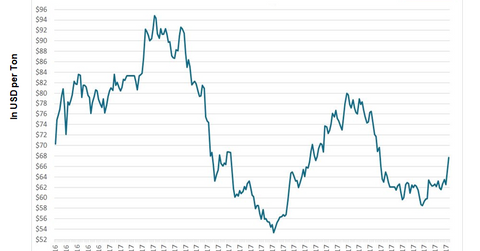Iron Ore Rebound: How Analyst Ratings for Miners Are Changing
Iron ore prices in 2017 so far have been a roller coaster ride. Prices reached a peak of $95 per ton in February only to slump to a low of $53 per ton in July and take off soon after.
Nov. 29 2017, Published 1:41 p.m. ET

Iron ore’s roller-coaster ride
Iron ore prices in 2017 so far have been a roller coaster ride. Prices reached a peak of $95 per ton in February only to slump to a low of $53 per ton in July and take off soon after. In September 2017, prices again came under pressure due to China’s impending cuts on steel capacity in winter. Prices fell 18% in a single week. They’ve again recovered and are hovering in the range of $60–$65 per ton. The latest wave of optimism in prices was due to elevated steel prices in China as capacity has shrunk while demand remains firm.
Iron ore miners’ performance
The performance of iron ore miners (PICK) has also been quite volatile in 2017. However, overall, seaborne players have gained year-to-date (or YTD). Rio Tinto (RIO), BHP (BHP), and Vale (VALE) have risen 24.3%, 14.9%, and 32.8% YTD, respectively, up to November 20.
Cleveland-Cliffs (CLF), on the other hand, has underperformed these miners by losing 26.6% in the same period. The factors driving CLF include the dynamics in the domestic US steel market, which have remained weaker than expected in 2017. It has little direct exposure to the seaborne market through its Asia-Pacific division.
Series overview
Changes in analysts’ estimates offer valuable insights into their market expectations. So it’s useful for investors to track these changes. After weakening, iron ore prices are now rebounding, lifting iron ore miners with them. Investors might want to know what the consensus is factoring in for them going forward.
In this series, we’ll analyze this key question with respect to individual miners by looking at their Wall Street analysts’ ratings and earnings estimates. Continue to the next part for a closer look at BHP.
